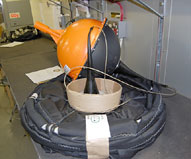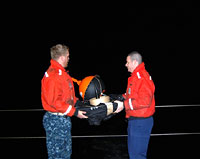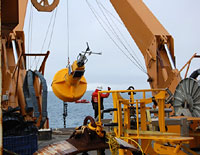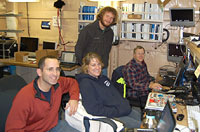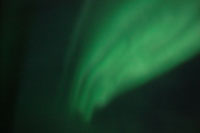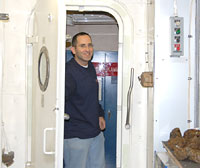

 | |||||||||||||||||||||
|
|
Journals 2009/2010Jonathan Pazol
September 15, 2009 In addition to the HARP moorings, there were several other science experiments that were being conducted over the past few days. In the middle of last night, several SVP (Surface Velocity Profiler) Ocean Drifters were deployed by the ice scientists. These buoys (they float) are designed to drift with the currents for up to 2 years. They include a GPS (Global Positioning System) device for location and also take readings of air pressure and surface temperature. The data collected from these will eventually be made part of the International Arctic Buoy Program, hosted by the University of Washington.
In addition to these, the Healy picked up a MET (Meteorological) Buoy that was deployed during a cruise earlier this year. Once the MET Buoy was located, the crew again went out on a RHIB (Rigid Hull Inflatable Boat) and attached a harness. The buoy was then lifted onto the deck with the winch and will be returned at the end of the cruise to the scientists who deployed it. MET Buoys are designed to collect data such as air temperature and wind speed, and include solar panels as part of its power system.
In the meantime, we continued with our mapping. "Team Bilbo," named after the Leonard Nimoy (yes, Spock from "Star Trek") song "The Ballad of Bilbo Baggins" that we played at odds times in the middle of the night, had its last midnight watch.
Staying up all night does have its privileges. At about 4 am we got a call from the bridge. The fog had lifted, and we could see the Aurora Borealis (the Northern Lights). They were swirling right around the North Star, which was right above our heads - nowhere but the Arctic can you have that experience!
We headed back north and went to "fill in holes" in the map data, especially along the foot of the slope of the Barrow Margin. We finally stopped collecting data, so that it could be processed and compiled. We spent part of the day preparing to disembark tomorrow. Rooms have to be cleaned, accounts at the ship's store have to be settled, and the last of the equipment needs to be packed up for shipment once the Healy reaches Seattle in early October. Helicopter flights will start once it gets light out, and hopefully fog will not be a problem. In the meantime, this will be my final entry from aboard the Healy. I'd like to officially thank Captain Frederick Sommer and the entire Coast Guard crew for making this expedition an amazing experience.
|
||||||||||||||||||||
